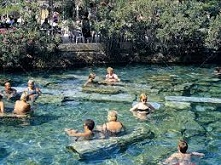Want to learn more about Pamukkale, Turkey? Read on to learn about the features of this unique world heritage site in Turkey…
Pamukkale is the name of a natural site in the southwestern region of the Denizli Province in Turkey. The name translates to Cotton Castle and the region is a unique geographical phenomenon that consists of Hot Springs, travertine and terraces made of carbonate minerals that have been created by the flow of the water. The exact location of Pamukkale places it in the inner Aegean region close to the River Menderes Valley.
Today the Pamukkale site attracts tourists from all around the world. In fact the site has been a popular tourist attraction for thousands of years. The unique natural mineral pools offer an intriguing experience to the masses. Over the course of time some areas of the site have been severely damaged but currently efforts are underway to restore some of the damaged springs.
Geology of Pamukkale
The terraces of Pamukkale are composed of a sedimentary rock called travertine which gets deposited by water that is excreted from the hot springs. The entire area of Pamukkale has a total of 17 hot water springs. The average temperature range in these springs falls between 35°C to 100°C.
As the spring excretes the hot water it flows about 320 m towards the head of the travertine. It deposits its calcium carbonate content in this region over an area of about 300 m. As the calcium carbonate, which is supersaturated with water reaches up to the surface, it releases the carbon dioxide and deposits the calcium carbonate. The depositing process continues until there is a balance between the carbon dioxide present in the air and the carbon dioxide present in the water. The deposited calcium carbonate is in the form of soft jelly which becomes hard over time and forms into travertine.
The specific weather conditions and the ambient temperature have an effect on the reaction of calcium carbonate. The reaction is also affected by the speed of the flow and its duration. Until the carbon dioxide present in the groundwater reaches a level of equilibrium with the carbon dioxide present in the air the precipitation process continues.
Atmospheric levels of carbon dioxide have been measured at the source of the springs at about 725 mg/I carbon dioxide. As the water flows across the travertine this number declines to 145 mg/I. This also causes a decline in calcium carbonate which falls down to 400 mg/I from 1200/I.
The Museum of Pamukkale
The Turkish authorities have converted part of the Pamukkale site into a museum that attracts people from all over the world. This museum has been built at the site of a former Roman bath which was developed in the ancient city of Hierapolis. The Hierapolis archaeology Museum was set up in 1984 alongside the historic artifacts from the ancient city. The museum also has artifacts from Collossae, Laodiceia, Attuda and other regions of the Lycos Valley. Today the Pamukkale site has earned recognition as a world heritage site along with the relics of the ancient city of Hierapolis.





